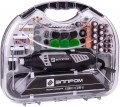Power consumption
The electrical power consumed by the tool during normal operation. Usually, the characteristics indicate the power at the maximum speed / frequency of movements of the working nozzle.
Usually, the higher this indicator, the more intense the tool can act on the material being processed, the better it is suitable for difficult conditions (large volumes of work, hard materials). At the same time, note that
high power significantly affects energy consumption; in mains-powered models (see below), this puts strain on the wiring, and in battery-powered models, it requires the use of bulky and heavy batteries and significantly reduces battery life. Yes, and this parameter significantly affects the dimensions, weight and price of the tool itself. Therefore, it is worth choosing a model according to power consumption, taking into account the specifics of the work for which it is planned to be used: for example, it hardly makes sense to purchase a high-performance professional tool for minor repairs around the house or in the country.
Specific recommendations on the optimal power values, depending on the type of tool and the purpose of its use, can be found in special sources.
Rotation speed
The speed of rotation of the working nozzle provided by the tool. Some models have a fixed rotation speed, others allow you to adjust it within a certain range (see "Number of speeds").
For different types of tools and types of work, different values of this parameter will be optimal; therefore, it is worth choosing taking into account the tasks that are planned to be solved using the tool (it is best to consult with special sources). We note only a couple of general patterns. So, for engraving on relatively soft and pliable materials (wood, glass, soft metals), high speed is not required, but for hard and difficult to process (steel, precious stones), a high-speed tool is better suited. But when drilling, note that for the same power consumption (see above), more revolutions, usually, means lower torque values. That is, here “high-speed” tools are better suited just for soft materials, and low-speed tools are better suited for hard and heavy materials.
Collet diameter
The diameter of the collet provided in the design of the rotary engraver (see "Device").
A collet is a specific type of fastening: a split sleeve, the “petals” of which can be compressed and unclenched by twisting / unscrewing the clamp. For a number of technical reasons, this mount is considered optimal for engravers. In order to properly install the working nozzle in such a tool, it is necessary that it fits the diameter of the collet (to be more precise, the mounting size of the nozzle should not exceed this diameter).
Note that there are several standard collet sizes. The most popular is 3.2 mm, but there are other options. And some engravers can be equipped with several mounts of different sizes.
Total number of nozzles
The total number of working attachments supplied with the tool.
The abundance of attachments allows the machine to be used with various materials and for various types of work. At the same time, this parameter significantly affects the cost. Therefore, when choosing, you need to proceed from how important a variety of possibilities is for you - so as not to overpay for extra nozzles that turned out to be useless in fact.
Note that this item is indicated only for engravers (see "Device") - for models of other types, specific types of nozzles are given in the corresponding item (see below).
Depth gauge
The presence of a
depth limiter in the design of the tool.
Such a device allows you to control the depth of penetration of the working nozzle when drilling or sawing. The design of the limiter may be different, however, anyway, it prevents immersion in the material to a greater depth than the specified one. This greatly facilitates the work: firstly, the risk of making a cut too deep or a hole is minimized; secondly, with an optimally set limiter, there is no need to regularly measure the depth — to obtain the desired cut or hole, it is enough to immerse the nozzle “up to the stop”.
Tripod
A
tripod is included with the instrument.
This function is found mainly among rotary engravers (see "Device"). The tripod is designed to hang the tool on it when working with a flexible shaft (see "Attachments") — usually, this is more convenient than simply placing the machine on a table or other surface. Without a tripod, this would have to use carnations, hooks or other similar devices — and they are far from being available everywhere, and they do not always provide reliable placement.
Weight
The weight of the tool can be indicated according to different rules: some manufacturers take into account only the body without a nozzle, others — with a standard working nozzle, for multi-tools (see "Device") the weight of the main unit without a replaceable head, etc. can be indicated. These points are usually specified in the specifications or detailed documentation.
In the case of a power tool, weight has a dual meaning. On the one hand, the smaller it is, the easier it is to hold the unit in your hands during long work and the more convenient it is to carry out fine, accurate processing. On the other hand, a light tool is less stable and has an increased tendency to jerk, which is important under difficult conditions and hard materials.

